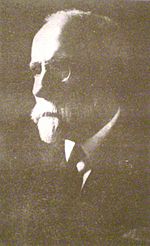Paul Groussac facts for kids
Quick facts for kids
Paul Groussac
|
|
|---|---|
 |
|
| Born | February 15, 1848 Toulouse, France |
| Died | June 27, 1929 (aged 81) Buenos Aires, Argentina |
| Occupation | Historian |
| Nationality | Argentine |
Paul-François Groussac (born February 15, 1848 – died June 27, 1929) was a famous writer, historian, and librarian. He was born in France but became an Argentine citizen. He was also known as a literary critic, which means he wrote reviews and opinions about books and other writings.
Contents
Life Story
Paul Groussac was born in Toulouse, France. His family was from an old region called Languedoc. When he was young, he studied classic subjects in his hometown.
In 1865, he was accepted into the École Navale, a naval school. However, he decided not to become a sailor. The very next year, in 1866, he moved to Buenos Aires, Argentina. This city became his home for the rest of his life.
Early Career in Argentina
For the next 17 years, Paul Groussac worked in different educational roles. He was a professor and also led the Escuela Normal in Tucumán. He also worked as an inspector for national colleges, making sure they were doing well.
In 1883, he took a trip back to France. After he returned to Argentina in 1885, he got a very important job. He became the head of the National Library of Argentina. He kept this important position for 44 years, until he passed away.
His Writings
Paul Groussac wrote many important books and essays. His most famous works are La Biblioteca (published in 1896) and Anales de la Biblioteca (published in 1900). These books were collections of his critical essays and historical stories about the library. They also included documents about the history of the Río de la Plata region in South America.
He was also in charge of a literary magazine called SudAmérica. This made him a very important person in the world of Argentine literature.
Key Themes in His Work
Groussac's writings often focused on history. Some of his well-known historical works include:
- Studies of Argentine History
- Historical Essay on Tucumán
- Mendoza and Garay
His writing style was known for being very detailed and factual. He was good at describing people and places in a clear and lively way. Other works he wrote include Forbidden Fruit, Argentine Tales, The Divisa Punzó, and Literary Criticism and the Malvinas Islands.
His Influence and Legacy
Paul Groussac's reputation grew even more after he died. This was partly because another famous Argentine librarian and writer, Jorge Luis Borges, often wrote about him. Borges even wrote Groussac's obituary, which is a notice of someone's death.
What Others Said About Him
Jorge Luis Borges greatly admired another writer named Alfonso Reyes. Borges once shared a quote from Reyes about Groussac: "Alfonso Reyes, the greatest prose writer in the Spanish language of any age, said to me: 'Groussac, who was French, taught me how to write in Spanish.'" This shows how much Groussac influenced other great writers.
As a critic, Groussac was known for having very strong opinions. He was sometimes seen as harsh or difficult. He was famous for his sharp and witty insults. Borges even wrote an essay in 1933 called Arte de injuriar (which means "The Art of Verbal Abuse"), where he looked at some of Groussac's literary criticisms.
Paul Groussac and Jorge Luis Borges had some interesting things in common. From 1955 to 1973, Borges held the same job as Groussac at the National Library. Both men also had poor eyesight. Sadly, both became completely blind by the time they finished their work as chief librarian.
See also
 In Spanish: Paul Groussac para niños
In Spanish: Paul Groussac para niños

